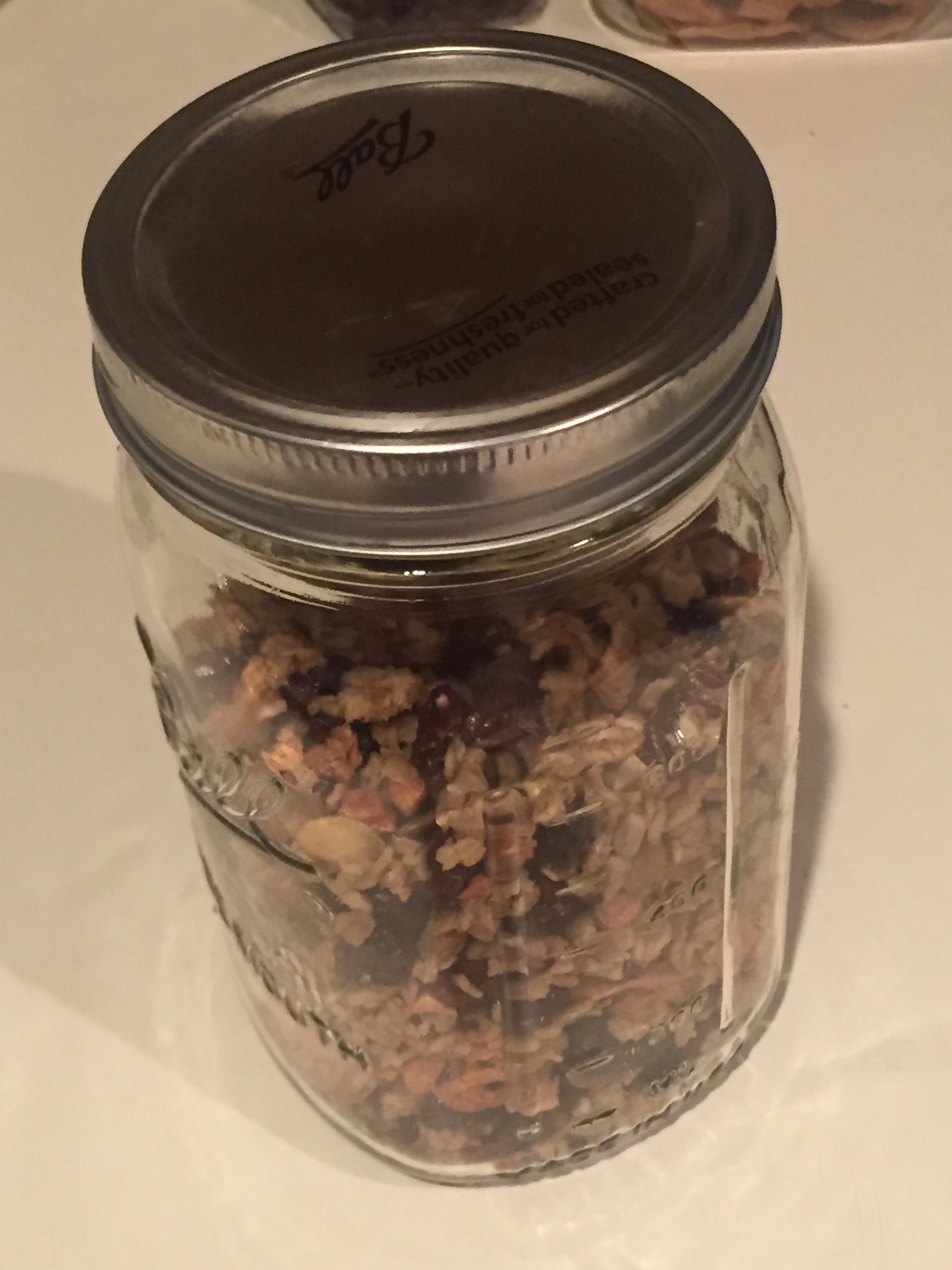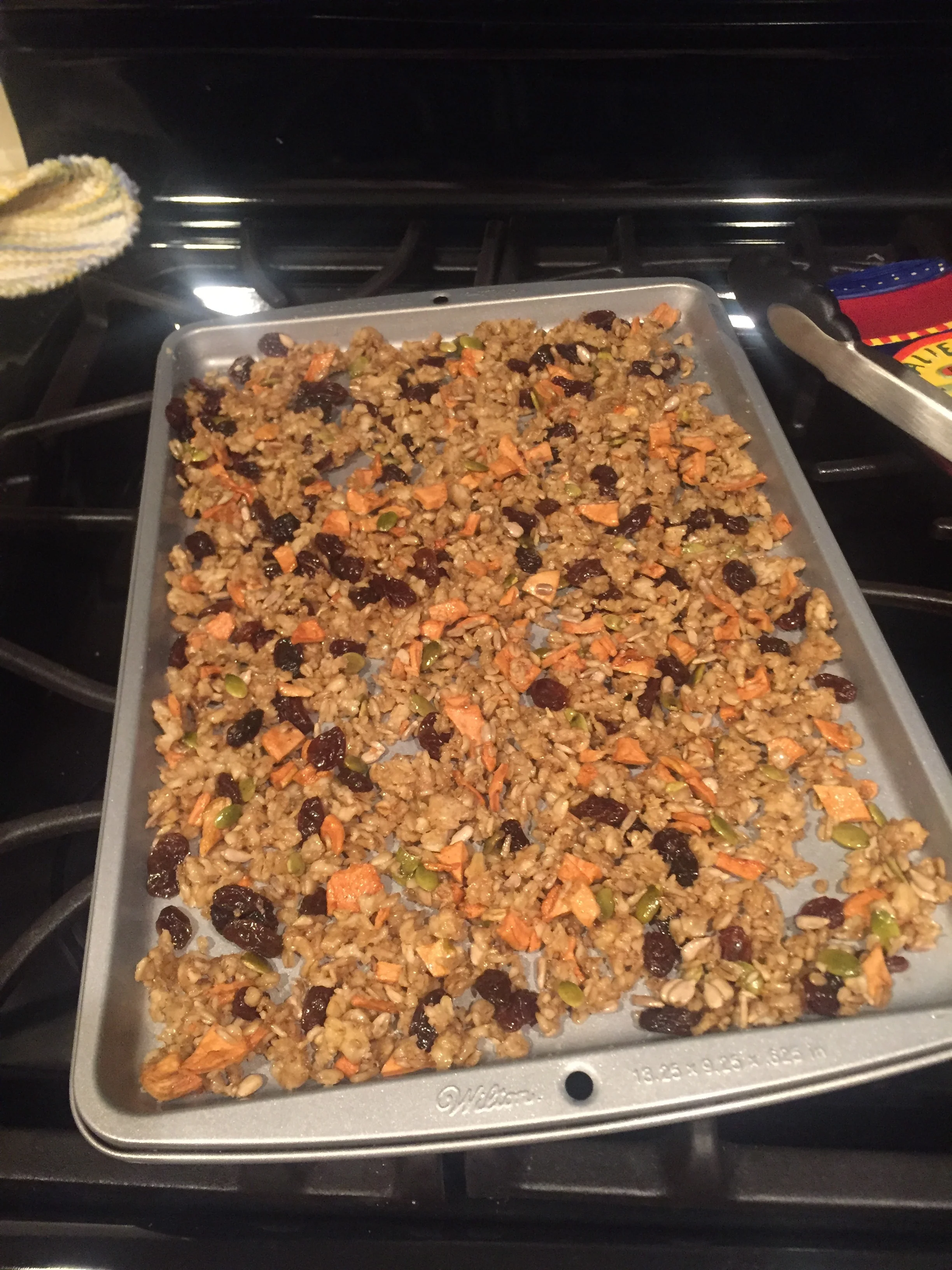I decided to experiment making "sprouted" granola because in my Vibrant Body program there are at least a couple of people who are vegetarian and have grains as a staple in their diet.
I don't personally eat a whole lot of grain because I do so much better with a diet that is mostly vegetables, fat and some protein. Actually, that's true for everyone... but some people do well eating more grains and beans than I do.
The challenge with seeds...
FYI... nuts, beans and grains are seeds. They give birth to future plants.
Part of the challenge with grains (wheat, corn, rice, oats, barley, millet, quinoa, etc.,) beans (including soy, chickpeas, lentils and peanuts... yes peanuts) nuts and seeds is that nature coats them in enzyme-inhibiting phytic acid that prevents your digestive system from breaking them down. This is the plant's wisdom to preserve its seed so it comes out the animal's "other end" intact, ready to sprout into a new plant. Phytic acid not only makes it hard to digest these foods, it also interferes in the assimilation of other nutrients, and is therefore considered an "anti-nutrient."
In order to render grains, beans, nuts and seeds more digestible, we should at a minimum soak them for a few hours before cooking. Ideally, beyond soaking we would sprout grains and beans over a few days. Sprouting not only reduces the content of the anti-nutrients present, but also reduces the starch content and makes the proteins more available for absorption.
In a nutshell, we should always (at the very least) soak grains, beans, nuts and seeds. How long to soak? Times can vary, but in general between 8-12 hours will do it ~ think, soak overnight to cook the next day. Or start soaking in the morning to cook in the evening.
Nuts and seeds can be dried at very low temperatures in the oven after soaking. Then stored in the fridge.
Boxed cereals have other issues too...
A lot of people like to eat granola or breakfast cereals in the morning. The added challenge of boxed cereals is that not only have the grains not been soaked or sprouted, in most cases they have been pushed through a machine called an extruder.
The extruder process is what puffs and shapes grains into crunchy breakfast cereals. This very high heat, high pressure process is so violent that it greatly damages the grains. The fats and proteins are altered, while the anti-nutrients are left intact. At least two studies have pointed out that extrusion renders grains toxic. (1, 2)
A better way to eat cereal
The best way to eat grains for breakfast is to soak them overnight, and add a teaspoon of apple cider vinegar or lemon for every cup of soak water to assist the removal of the phytic acid. The next day, discard the soaking water and rinse the grains thoroughly. Cook your grains as you would normally, and ideally add a source of fat (i.e. butter, coconut oil or your ready soaked-and-dried nuts and seeds.)
Granola
Some people love the crunch and mixed flavors of granola. But again, store-bought granola is not soaked and only dry-roasted, often at high temperatures.
So let's make our own "sprouted" granola. Rolled oats won't actually sprout because the grain has been flattened, but by soaking you are taking the first step of the sprouting process. You could do this with intact whole oats, but they are harder to find.
"Sprouted" Granola
1. Soak your oats in at least 2X water for the amount of oats you measured. Add 1 tsp apple cider vinegar or lemon per cup of water. Soak overnight. *
I also added pumpkin seeds and sunflower seeds to my granola, which I had already soaked and dried. If you choose to add nuts or seeds to your granola, soak them overnight as well.
* Because oats don't have a lot of phytase (the enzyme that helps remove phytic acid) it's usually best to add 1-2 tbsp of buckwheat to your oats as it is very high in phytase.
2. Put your mushy oats in a mesh sieve and rinse them really well. Then use your fist to squeeze some of the water out.
Also rinse and drain your nuts and seeds.
3. Spread the oats on a cookie sheet and dehydrate them on the lowest setting in your oven. Mine is 170 degrees. You'll have to dry them for about 3 hours. I did 1.5 hours, then flipped them over with a spatula, and dried for another 1.5 hours.
Do the same with your nuts and seeds of choice.
4. Break apart your oats in a bowl. I used a spatula to separate the oat clumps.
Add your granola ingredients of choice. I used raisins, cut-up dried apples, pumpkin seeds and sunflower seeds.
5. Add 1/2 tsp to 1 tsp cinnamon. This is a great addition to any sweet food as it slows down your body's absorption of the sugars that are present.
6. Sweeten with maple syrup to taste. I added about 1 tablespoon to the whole bowl. Adjust to your liking, knowing that less sugar is always better.
7. Add 1 tbsp of avocado oil or melted coconut oil. The oil will make the granola crunchy, but you have to use an oil that can stand the high heat. Do not use canola, corn, soy, etc. as these oils are quickly damaged with heat.
8. Toss to coat everything evenly.
9. Dehydrate at 200-250 degrees for about 1-2 hours until it's beginning to turn slightly golden. Do NOT brown or increase the heat beyond that.
10. Store in a glass container in the fridge. Soaked and dried grains, nuts and seeds will spoil quicker than when they are untreated, precisely because you've removed most of the phytic acid.
Voila!
Again, if you're a fan of grains, try to get into the groove of eating them only after soaking/sprouting. This also applies to breads, by the way. So sprouted or soured breads are always going to be more digestible. Clearly you won't be able to do this 100% of the time, but try the best you can.
References:
1. Stitt, Paul, Beating the Food Giants, 1981, Natural Press, Manitowoc, WI, 62.
(In the book, Stitt gives his personal account as a former Quaker employee, of seeing a 1942 Quaker study where rats fed puffed wheat dying within 2 weeks. Rats fed only water and liquid vitamins lived longer. The Quaker study was never published but has been replicated by other researchers. Stitt points out that no human studies or animal studies are conducted by the cereal industry to prove safety or health benefits of eating boxed cereal.)
2. Jenkins, David J A, et al, American Journal of Clinical nutrition, March 1981, 34:362-366.





